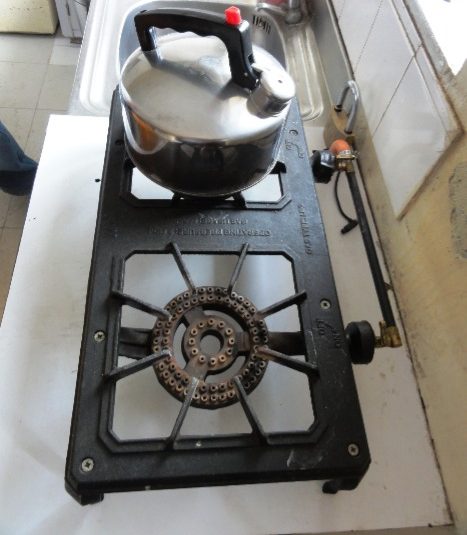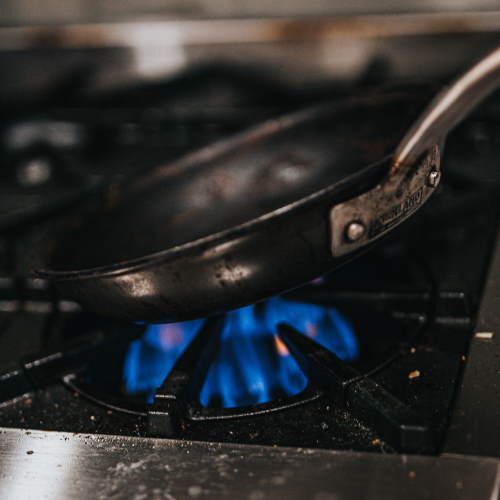An in-depth article about biogas stoves, covering everything for small scale digesters and home cooking with what in India is known as gobar gas. Read on for the info on biogas stoves:
On This Page
- What is a Biogas Stove?
- Stoves for Small Scale and Home Biogas
- Potential Improvements From Biogas Stoves
- Domestic Appliances Running on Biogas
- Cost of household biogas systems
- Using a Biogas Stove
- Using a Regular LPG Stove
- How to Modify a Normal LPG Stove to Run on Biogas
- LPG Stoves Versus Biogas Stoves
- Methane Used in Puxin Biogas Stove
- Puxin Biogas Oven
- Biogas Fuel Stove with Single Burner
What is a Biogas Stove?
A biogas stove is a specially adapted, stainless steel, countertop, or built-in, biogas fuelled stove.
Using a stove which is either intended or modified, to run on biogas (gobar gas) is the easiest method for home and small scale, biogas digester beginners. These stoves are small, most have no more than two burner rings, and are often portable. They can usually be positioned as needed in order to accommodate other kitchen appliances on the countertop.
They are most often manufactured from stainless steel or cast-iron. Some can be used as a built-in single burner stove specially adapted to cook with biogas. One brand of biogas stove is designed to slide into a stove range or be built into a countertop and is perfect for those who have limited kitchen space.
Biogas is the gaseous product of breaking down organic matter in the absence of oxygen (see "Anaerobic Digestion"). It can be used to meet the energy need for cooking and baking in individual households as well as in small businesses.
Stoves and ovens for biogas application are similar to conventional appliances that run on commercial fuels such as butane and propane. However, special modifications (particularly in the design of the burners) are required in order to ensure proper combustion and the efficient use of energy.
At this website, we have received so many queries regarding the non-availability of Biogas Stoves, and we are not quite sure why so few are on the market for sale. We assume that the reason is that the demand for biogas stoves is so low compared with other fuels that stores do not consider it worthwhile to stock them. It is difficult to buy biogas stoves both in rural areas and in big cities.

CC BY by Sustainable sanitation
However, not many people are aware that you can use a normal LPG stove to run on biogas with simple modifications. In fact, you will not find much difference if you look at both an LPG Stove and a Biogas Stove normally.
Most of these conventional appliances can be adapted for the use with biogas by the modification of the burners to ensure proper combustion and efficient use of energy.
Several grassroots and nonprofit organizations (such as Heifer International and it's partners) have in recent years started biogas fueled stove manufacturing projects to allow people in impoverished communities to have a sustainable way to cook their food and heat their homes.
Stoves for Small Scale and Home Biogas
By far the biggest demand for biogas stoves comes from the millions of small scale domestic and smallholding type biogas plants ranging in design from digesters based upon oil drum sized vessels all the way up to the community (e.g. village) biodigesters built in-pits with masonry walls and covers.
The gas pressure at which these stoves must operate is low and highly variable, and the same goes for the proportion of methane present.
One thing that doesn't change though, is that biogas burns over a narrow range of mixtures containing 9 to 17 per cent of biogas in the air. If the burning flame has too much gas, the burn will be poor and incomplete, giving off poisonous carbon monoxide and contain a lot of soot particles. via babiogas
A good biogas stove design aims to maximize the conversion of methane and to reduce unburned methane and soot from incomplete combustion. For this reason, a biogas stove design should burn on the lean side with a small amount of air to avoid the flame becoming rich. In a good biogas stove design, the air is mixed with the gas prior to when it is burned to ensure the correct air-gas mix is obtained. There are other problems to solve which are known as:
- lighting back,
- flame lift,
- pressure drop at the burner manifold.
A successful biogas stove design must avoid those problems and deliver the flame where the heat of combustion can efficiently conduct its warmth into the cooking vessel.

Potential Improvements from Biogas Stoves
Stoves and ovens using biogas have the potential to improve the wellbeing of marginalised people. They offer an excellent opportunity to put an end to the indoor air pollution generated in the kitchens of many poor families around the world, as well as treating organic waste that commonly represents health and environmental threats.
Local manufacturers of biogas stoves are, therefore, emerging in many countries. There appears to be significant potential to improve the combustion efficiency and overall quality of the stoves which are currently being offered on the market. It is hoped that as sales increase competition will become greater and the sellers with then match the quality of today's best gas stove brands.
Domestic Appliances Running on Biogas
As a gaseous fuel, biogas can be used for many domestic tasks. A common practice is the adaptation of commercial appliances that originally ran on fossil fuel gases, such as liquefied petroleum gas (LPG) or natural gas.
Biogas from small digesters may contain carbon dioxide and water vapour and is at low pressure flows out of burner holes. It flows through stoves with less volition and therefore has a lower calorific value than LPG (or natural gas) and therefore cannot be used to run normal LPG gas appliances. Regular appliances can be modified to run on biogas by enlarging apertures (theoretically a simple process, but a lot more tricky in practice).
There are a number of domestic appliances in addition to Stoves and Cookers which can be fuelled biogas. These are:
- Biogas Lamps
- Radiant Heaters
- Incubators
- Refrigerators
- Biogas-fuelled Engines including modified:
- Four-stroke Diesel Engines
- Four-stroke Spark-ignition Engines.
Cost of Household Biogas Systems
Costs for any plant require initial investment costs and once built, they also incur running costs. Considering the initial capital cost versus the financial and environmental benefits is important. It is estimated that an 8 m3 household biogas tank can treat the manure from 4 to 6 pigs, yielding around 385 m3 biogas annually. That suggests that such a plant can save 847-1,200 kg of coal-based on the calculation of effective heat equivalent. According to the methodology recommended by IPCC in 2006, if a household biogas digester treats the manure of 4 pigs, it can reduce GHG of 1.5~5.0 tonnes CO2e.
The initial equipment purchase and installation costs of each household biogas digester (8-16 m3) range from US$500 to US$1,000 depending on the digester size. Most rural households within developing countries have low disposable income and weak financial capacity for making such a large investment. In addition, the household will continue to pay a biogas digester maintenance cost. By contrast, the current practice of deep-pit treatment method is by far considered the most attractive option for manure treatment given that it requires very limited additional investment and labour input. via www.ctc-n.org
The cost functions for a biogas plant are thought of by one research group as being:
- The economies of scale
- The ratio of the cost of a given size of the plant to the cost of a reference plant (this remains almost constant over time)
- The effect of retention time and other factors on the capital cost
- The costs of the material (if it must be brought in from outside the farm or home).
Using a Biogas Stove
Biogas can be used in gas appliances for energy production which is then used for heating, lighting, the supply of steam plants, in water boilers, gas stoves, infrared radiators and internal combustion engines.
The simplest method of biogas utilization is using it in burners, as it can be directly supplied from low-pressure gas holders, but it is more preferable to use biogas for mechanical and electrical energy production. The best biogas stove sellers offer designs that are specifically developed for the low-pressure gas burners needed to burn biogas direct from small digesters or from storage holders containing biogas.
Gas pipes are also needed that can effectively connect the point where you collect the accumulated biogas and the stored gas through gas lines to the home stove.
The stainless steel, built-in single burner stove is specially adapted to cook with biogas. The HomeBiogas stove is designed to slide into a stove range or be built into a counter-top and is perfect for those who have limited kitchen space.
After selecting the type of digester, the retention time, which is a key parameter in determining digester size, is chosen to maximize the percentage of production of biogas with respect to the retention time. 10 to 30 days is often chosen as the minimum amount of time for sufficient bacterial action to take place to produce biogas and to destroy many of the toxic pathogens found in human waste, considering the diameter and height of the mixing pit are equal.
At the household level, biogas systems can also be used to produce fertilizer and for providing energy for cooking and lighting.
Safety pilot and air filter Biogas-fueled radiant heaters should always be equipped with a safety pilot, which turns off the gas supply if the temperatures go low i.e. the biogas does not burn any longer.
Biogas consumption can be calculated from assuming that household burners consume 0.2 to 0.45 m3 of biogas per hour and industrial burners – from 1 to 3 m3 of biogas per hour. Biogas volume, necessary for food preparation can be determined from the time spent on daily cooking.
Using a Regular LPG Stove
Using 1-2 burners for biogas in addition to your current LPG stove is a good way to set up a kitchen to use biogas whenever possible. If a user chooses to connect a "HomeBiogas"™ digester to a regular stove, the user should be aware of the energy requirement of the stove.
The Biogas stove is different from the LPG regular stove since low compressed bio-methane is a far less compressed gas than LPG, the gas burner flame openings need to be wider for better combustion.
The first time that a new digester set-up is used, the gas in the tank won't burn as it contains Carbon Dioxide gas. If, fortunately, it burns then good, or else wait for the second time after draining the first tank-load of gas. The second use will be likely to be much better quality biogas, and thereafter will usually be good methane. You can detect how much gas there is in the system when the gas holder tank rises up as the gas is produced.
How to Modify a Normal LPG Stove to Run on Biogas
So it is very difficult biogas stoves in big cities. However, you can use a normal LPG stove to run on biogas with simple modifications. You will not find much difference if you look at both LPG Stove and Biogas Stove normally.
The Biogas Burner I am showing has 3 mm holes in it. Take an LPG stove, unscrew and remove the nozzle, and this may be enough, also close any air-entraining/ mixing gap provided for LPG use. You can control the pressure and required amount of biogas with the gas control knob provided.
Check by comparison with existing burner the operation of it with biogas after removing the nozzle. If it is burning properly, then leave it as it is otherwise necessary to search for a burner of the same diameter. Burners are of different sizes. So take your LPG burner when searching. In our locality, there are hardware stores fabricating and selling local-made stoves for biogas use.
[caption id="attachment_4664" align="alignleft" width="500"] CC BY by DFID - UK Department for International Development[/caption]
CC BY by DFID - UK Department for International Development[/caption]Once you did the modifications, Connect Biogas pipeline to your stove and check your stove and it should run on biogas properly. via ww.instructables.com
Do not add anything other than cow dung slurry and organic waste. Once gas formation starts, you can feed organic waste in small quantities. Make sure there is no leakage. Also, be aware that the initial gas produced will not burn as it will be mostly carbon dioxide.
Release the gas 2 to 3 times before testing. Use a Bunsen burner to test and DO NOT use a lighted match stick for testing. If the gas pressure is too low to fuel the bunsen burner, add some weight on top of the gas holder to get a better pressure.
LPG Stoves Versus Biogas Stoves
Almost any gas stove can be converted to support biogas by removing the pressure nozzle. However, one stove cannot supply both LPG and biogas.
For an LPG stove versus Biogas stove, the LPG stove wins for its low cost for a high-quality product. Lightweight and portable. Check that the one you buy has easy to use heat adjustment dials.
Against this background, for the biogas stove, you will most likely need a match to light the stove. In addition, heat adjustment is not precise.
If you're looking for something simple on holiday, a butane stove can be perfect for you. It's our favourite, for a solo camper looking to make a simple but delicious meal is a cheap LPG stove.
However, for the poor and any environmentally aware person, the biogas stove is considered far better with its wonderfully "green" environmental benefits and its value in reducing the unhealthy smoke found in so many developing nations in houses where wood would be the only economically alternative cooking fuel.
Methane Used in Puxin Biogas Stove
From its first decade, the Puxin methane program was a success. It installed more than 20,000 biogas stoves (or biodigesters) in that period. Digesters that enable rural households to turn the waste of their cows and pigs into a methane-rich gas suitable for both cooking and lighting, as well as bio-slurry (predominantly used as a substitute for fertilizer).
To begin explaining biogas stoves, it is probably useful to first think about what "biogas" is? biogas is essentially another word for
For instance, the 5,000l package comes with the digester, one purifying biogas (methane purifier) MP 12 135 (PVC), a gas holder with a capacity of 5 m3, one generator bg 2500 w (biogas power generator 2500 watts), bacterial methane activators gp-7 for 1 month, installation of equipment, and stoves. a gas mixture that is predominantly made up of methane (CH4) and carbon dioxide (CO2).
Puxin Biogas Oven
Cookstoves and ovens for biogas application are similar to those of conventional appliances running on commercial gas-fuels. A biogas stove usually has a single or double burner with varying gas consumption rates, which is influenced by the pressure provided by the biogas plant and the diameter of the inlet pipe.
Stoves and ovens for biogas application are similar to conventional appliances that run on commercial fuels such as butane and propane.
Biogas Fuel Stove with Single Burner
Biogas combustion is so much cleaner than other fuels, such as solid biomass and kerosene, that it must be considered. However, for these advantages to make it worth buying a biogas stove it depends on the quality of the biogas stove (particularly the burner).
The HomeBiogas™ stainless steel, built-in single burner stove is specially adapted to cook with biogas. This stove is designed to slide into a stove range or be built into a countertop and is perfect for those who have limited kitchen space.
1 comment:
Sir, I want to promote and opened a biogas market in Nigeria. How can I become your agent or distributor?
Post a Comment